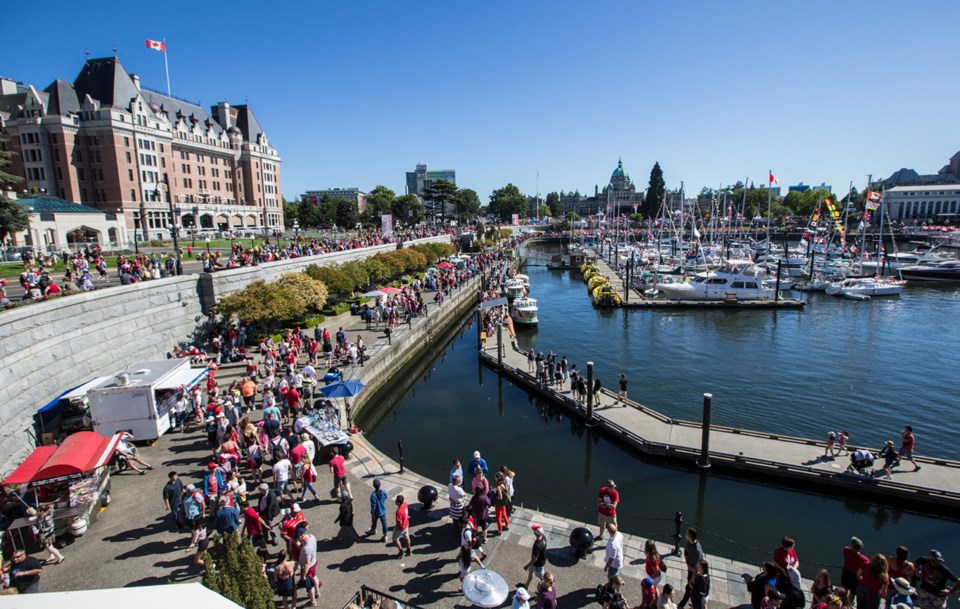With no investment in new hotels, Greater Victoria’s tourism industry will have difficulty repeating this year’s strong results in 2019, say industry insiders.
Hard on the heels of the release of tourism indicators for October showing the region with hotel occupancy above 78 per cent through the first 10 months of the year, experts say the region is near capacity.
“[This] will be a very strong year ... we will have difficulty replicating it in 2019, but we will try,” said Paul Nursey, chief executive of Destination Greater Victoria.
A leading indicator of the strength of the sector is average hotel occupancy.
Figures collected by Chemistry Consulting show the average occupancy at 78.37 per cent through the end of October, up from 76.4 through the same period last year.
Meanwhile revenue per available room increased $16 to $149.14 through the first 10 months of the year.
Frank Bourree, principal of Chemistry Consulting, called the figures “pretty amazing,” but they also reflected the fact the region has lost a lot of rooms.
“In the past 10 years, Victoria has lost 17 hotels and over 1,100 rooms to condo or social- housing development,” he said.
Bourree said with occupancy over 78 per cent, he would have hoped a hotel developer would have stepped up already.
Bourree and Nursey said over the last two years there have been several groups interested in building hotels, but so far no action has been taken.
Focus Equities founder Ken Mariash has long noted he would like to build a hotel as part of the Bayview project in Songhees, and there have been suggestions a hotel could be part of a revitalized Ogden Point. But they are years away from hitting the market.
Bourree said that can have a number of ripple effects through the region, from having people turned off by more expensive hotel room rates, to the region no longer being able to host summer festivals as there is simply nowhere for people to stay.
Bourree said there’s little wonder Destination Greater Victoria is pushing off-season business and conference business, though even that could be jeopardized by the lack of rooms.
Conference business has been a bit of a bright spot for Destination Greater Victoria, which took over the marketing of the Victoria Conference Centre in 2017.
That year the centre had 108,836 delegate-days, a 1.8 per cent increase over 2016’s 106,808, which translated into a 3.5 per cent increase in the number of room nights sold to 26,399 last year.
Through just 10 months of 2018, the Conference Centre has already surpassed those numbers.
To date the Conference Centre has booked 109,342 delegate days, a 14 per cent increase over the same period last year.
Nursey said that reflects more effort and resources in booking meetings into the facility. Destination Greater Victoria has earmarked $1.1 million for its meetings program, up from the $600,000 the city had set aside for it. “That’s’ the power of alignment,” he said.
Nursey concedes the region needs more hotel rooms to help grow that business and the leisure business, and he said there are still groups looking around.
He remains optimistic something will happen soon.
B.C. Ferries continued to report strong numbers in October; year-to-date the corporation has seen a 2.27 per cent increase in vehicle traffic on its busiest route between Swartz Bay and Tsawwassen, and a 1.18 per cent increase in passenger numbers.
Victoria International Airport continued its record year, as year-to-date it has seen 1.732 million passengers through its gates, an increase of 0.44 per cent from 2017.
And increases could be in the cards again next year, even if the region may not have enough hotel rooms to deal with them.
Destination B.C.’s recently released 2019 Global Marketing Strategy expects visitation growth anywhere between one per cent and 7.5 per cent from its main markets, with the largest increase expected to come from Mexico.
Bourree said Victoria, and the rest of Canada, could benefit from the global view of the U.S. “The U.S. is one of the biggest tourism destinations in the world, but people are avoiding it because of the politics,” he said. “We are a friendly option.”
Nursey said Victoria’s ability to cash in on those forecast increases will come down to transportation capacity, as the ferry system is already being pushed to its limits.
“I think 2019 will be a softer year,” he said. “There’s no emergency by any means, we are just at nearing the end of a long economic upswing and I do see some moderation next year.
“There will be a plateauing, which is not a bad thing, as we’ve seen double-digit growth for a long time.”



